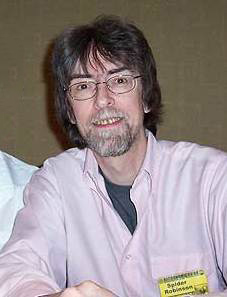
Robert Anson Heinlein was an American science fiction author, aeronautical engineer, and naval officer. Sometimes called the "dean of science fiction writers", he was among the first to emphasize scientific accuracy in his fiction, and was thus a pioneer of the subgenre of hard science fiction. His published works, both fiction and non-fiction, express admiration for competence and emphasize the value of critical thinking. His plots often posed provocative situations which challenged conventional social mores. His work continues to have an influence on the science-fiction genre, and on modern culture more generally.

Starship Troopers is a military science fiction novel by American writer Robert A. Heinlein. Written in a few weeks in reaction to the US suspending nuclear tests, the story was first published as a two-part serial in The Magazine of Fantasy & Science Fiction as Starship Soldier, and published as a book by G. P. Putnam's Sons on November 5, 1959.

Between Planets is a juvenile science fiction novel by American writer Robert A. Heinlein, originally serialized in Blue Book magazine in 1951 as "Planets in Combat". It was published in hardcover that year by Scribner's as part of the Heinlein juveniles.

The Man Who Sold the Moon is the title of a 1950 collection of science fiction short stories by American writer Robert A. Heinlein.

Alastair Preston Reynolds is a Welsh science fiction author. He specialises in hard science fiction and space opera.

Spider Robinson is an American-born Canadian science fiction author. He has won a number of awards for his hard science fiction and humorous stories, including the Hugo Award 1977 and 1983, and another Hugo with his co-author and wife Jeanne Robinson in 1978.

Sean Christopher McMullen is an Australian science fiction and fantasy author.

Garth Richard Nix is an Australian writer who specialises in children's and young adult fantasy novels, notably the Old Kingdom, Seventh Tower and Keys to the Kingdom series. He has frequently been asked if his name is a pseudonym, to which he has responded, "I guess people ask me because it sounds like the perfect name for a writer of fantasy. However, it is my real name."
John Barnes is an American science fiction author.

John C. Wright is an American writer of science fiction and fantasy novels. He was a Nebula Award finalist for his fantasy novel Orphans of Chaos. Publishers Weekly said he "may be this fledgling century's most important new SF talent" when reviewing his debut novel, The Golden Age.

Kij Johnson is an American writer of fantasy. She is a faculty member at the University of Kansas.

Peter Watts is a Canadian science fiction author. He specializes in hard science fiction. He earned a Ph.D. from the University of British Columbia in 1991 from the Department of Zoology and Resource Ecology. He went on to hold several academic research and teaching positions, and worked as a marine-mammal biologist. He began publishing fiction around the time he finished graduate school.
The Golden Age of Science Fiction, often identified in the United States as the years 1938–1946, was a period in which a number of foundational works of science fiction literature appeared. In the history of science fiction, the Golden Age follows the "pulp era" of the 1920s and '30s, and precedes New Wave science fiction of the '60s and '70s. The 1950s are, in this scheme, a transitional period. Robert Silverberg, who came of age then, saw the '50s as the true Golden Age.

Ellen Klages is an American science, science fiction, fantasy and historical fiction writer who lives in San Francisco. Her novelette "Basement Magic" won the 2005 Nebula Award for Best Novelette. She had previously been nominated for Hugo, Nebula, and Campbell awards. Her first (non-genre) novel, The Green Glass Sea, was published by Viking Children's Books in 2006. It won the 2007 Scott O'Dell Award for Historical Fiction. Portable Childhoods, a collection of her short fiction published by Tachyon Publications, was named a 2008 World Fantasy Award finalist. White Sands, Red Menace, the sequel to The Green Glass Sea, was published in Fall 2008. In 2010, her short story "Singing on a Star" was nominated for a World Fantasy Award. In 2018 her novella Passing Strange was nominated for the Mythopoeic Fantasy Award for Adult Literature.

Jonathan Strahan is an editor and publisher of science fiction, fantasy, and horror. His family moved to Perth, Western Australia in 1968, and he graduated from the University of Western Australia with a Bachelor of Arts in 1986.

Variable Star is a 2006 science fiction novel by American author Spider Robinson, based on the surviving seven pages of an eight-page 1955 novel outline by the late Robert A. Heinlein. The book is set in a divergent offshoot of Heinlein's Future History and contains many references to works by Heinlein and other authors. It describes the coming of age of a young musician who signs on to the crew of a starship as a way of escaping from a failed romance. Robinson posted a note on his website in 2009 noting that his agent had sold a trilogy of sequels based on the novel and its characters.
"The Return of William Proxmire" is a short story by Larry Niven first published in 1989 in the anthology What Might Have Been? Volume 1: Alternate Empires, edited by Gregory Benford.

Hannu Rajaniemi is a Finnish American author of science fiction and fantasy, who writes in both English and Finnish. He lives in Oakland, California, and was a founding director of a commercial research organisation ThinkTank Maths.

Beyond the Aquila Rift is a 2016 collection of science fiction short stories and novellas by British author Alastair Reynolds, published by Gollancz, and edited by Jonathan Strahan and William Schafer. It contains works previously published in other venues. The collection features several stories connected to Reynolds's previous stories and novels. "Great Wall of Mars", "Weather", Last Log of the Lachrymosa, and Diamond Dogs take place in the Revelation Space universe, Thousandth Night takes place in the same universe as House of Suns, and "The Water Thief" takes place in the Poseidon's Children universe.

Fran Van Cleave is an American author of libertarian science fiction, born in Boston and educated as a pharmacist. She was an active member of the Libertarian Futurist Society for many years and served as director of the society in 2005. Van Cleave's works include adventure stories with young protagonists, influenced by the Heinlein juveniles. In addition to fiction, Van Cleave has published articles on scientific topics in Analog Science Fiction and Fact.

















